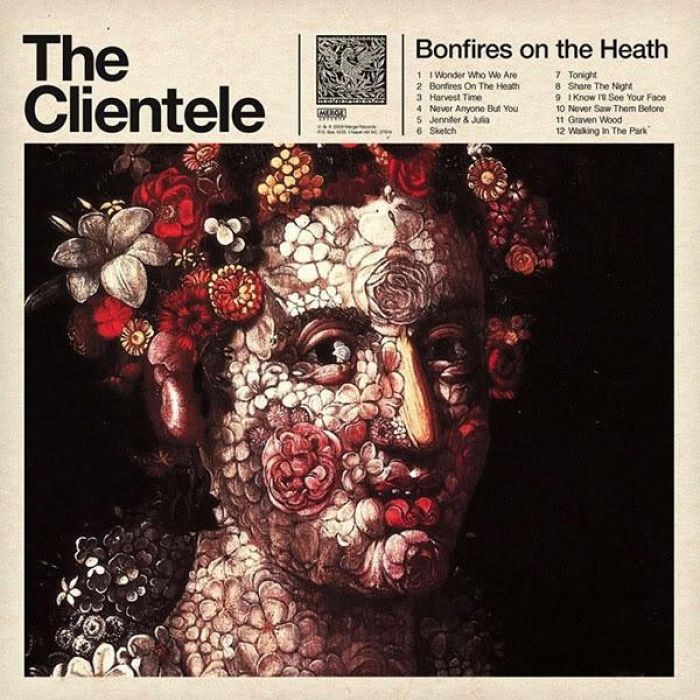Bonfires on the Heath by The Clientele (Review)

Clientele albums have always been full of ghosts — ghosts of childhood, of past relationships and lovers, and so on — as well as a sense of the impermanence of this mortal coil. And Bonfires on the Heath continues on that spectral track — indeed, it wouldn’t be the Clientele if the songs weren’t somewhat unsettling amidst the sublime pop beauty. But this time around, the Clientele’s songs feel even more crowded than usual, more unsettling, more impermanent.
While Alasdair MacLean still sings about past lovers and childhood, he also taps into imagery that is more ancient and otherworldly, referencing the passing of time, old traditions and rituals, and other things that feel far removed from the urban climes that often serve as the setting for his songs. This time around, it feels like MacLean and his bandmates are journeying deeper into the old country, deeper into the undergrowth, farther out into the rural landscapes.
As a result, Bonfires on the Heath is probably the most primal Clientele album to date. That’s not to say that the music is ever anything less than elegant and refined. But it is spookier and more ephemeral than ever before.
On the title track, MacLean sings:
Kids all jumping bonfires on the heath
Kids all jumping bonfires on the heath
How’m I going to get myself to sleep?
Sure, there’s a reference to childhood, but one gets the sense that MacLean isn’t referencing a cherished memory. The last line conjures up darker undertones, especially when taken in the context of the next stanza, where MacLean notices “Late October sunlight in the wood/Nothing here quite moves the way it should” as if he’s passed some ley line dividing this world from the next.
This sensibility is best captured in “Harvest Time,” the album’s most haunted moment. Here, MacLean sings:
Bats from the eaves go shivering by
Scarecrows watch the verges of light
I hear a choir on the heath at night
But no one’s there
A ghostly chorus consisting of MacLean and Mel Draisey simply intone “It’s harvest time” for the refrain. It’s one of the creepiest things the band has recorded, as if MacLean is describing some ancient ritual or tradition that he’s stumbled across while tromping around Britain’s haunted fields.
Some might say I’m reading too much into the lyrics, and that the Clientele’s music has always been about mood first, and that the lyrics are just another instrument for all intents and purposes. And to be honest, that’s how I’ve often approached their music — not because I find the lyrics trite and silly, but because the music is so smooth and elegant that I’m usually content to simply stop there and enjoy the chiming guitars, piano and horn arrangements, and graceful basslines.
However, I’ve found myself paying a little more lyrical attention this time around. The Clientele may not be the most verbose or effusive of bands, but they’ve always trafficked in obscure and surrealist texts that lends their music a unique effect. And when I read MacLean’s observations on the album (say, in this Pitchfork interview), it’s difficult to simpy dismiss the words and images in songs like “Harvest Time” and “Graven Wood” as mere writing exercises.
But it does go deeper than the lyrics, as beguiling and intriguing as they may be. The Clientele’s sound is as assured and consistent as ever, and the mood that is created by the foursome is truly sublime, containing glorious pop hooks and delicate, otherworldly textures in equal measure. While not as experimental or varied as God Save The Clientele (you won’t hear any, say, disco a la “Bookshop Casanova”), Bonfires on the Heath still brings plenty of variety to the Clientele’s sound without ever making it lose any of its Clientele-ness.
“I Wonder Who We Are” is as punchy as anything in the band’s catalog, with tasteful piano and horn melodies and Spanish guitar flourishes building on top of the band’s already solid sound. A lonesome lap steel winds its way through the aforementioned “Bonfires on the Heath,” doing absolutely nothing to disturb the song’s otherworldly air; the same goes for the skeletal piano refrain on “Harvest Time,” which gels quite nicely with MacLean’s langorous guitar and the ghostly vocals. And for good measure, a Morricone-ish trumpet gloriously and unashamedly struts its stuff on “I Know I’ll See Your Face.”
A Clientele album is never simply a pop album, though they are, without a doubt, an extremely accomplished — and sadly underappreciated — pop group. There’s too much happening behind the music to simply dismiss it, and that’s especially true here. The band’s music and lyrics have never been this ephemeral, this lost (in the sense of being caught up in the rapture, wonder, and fear of what they’re doing). And while the band’s music has always been melancholy, there’s a special sadness in Bonfires on the Heath, a British take on the Japanese concept of “mono no aware.”
On the album’s final track, MacLean sings of walking through the park and reminiscing of school days before concluding “I don’t know what more I can say.” In the aforementioned interview, the notion of this being the final Clientele album is discussed — a sad thought but one that’s not too surprising given that a sense of mortality and finality fills this album like no other Clientele recording (that I’ve heard, any ways).
If this does unfortunately turn out to be the case, than I can’t imagine a better swansong than Bonfires on the Heath. Indeed, one does feel that this is the album the Clientele have been working towards throughout their entire career.